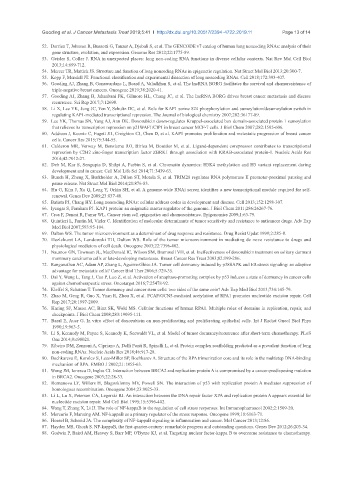Page 322 - Read Online
P. 322
Gooding et al. J Cancer Metastasis Treat 2019;5:41 I http://dx.doi.org/10.20517/2394-4722.2019.11 Page 13 of 14
52. Derrien T, Johnson R, Bussotti G, Tanzer A, Djebali S, et al. The GENCODE v7 catalog of human long noncoding RNAs: analysis of their
gene structure, evolution, and expression. Genome Res 2012;22:1775-89.
53. Geisler S, Coller J. RNA in unexpected places: long non-coding RNA functions in diverse cellular contexts. Nat Rev Mol Cell Biol
2013;14:699-712.
54. Mercer TR, Mattick JS. Structure and function of long noncoding RNAs in epigenetic regulation. Nat Struct Mol Biol 2013;20:300-7.
55. Kopp F, Mendell JT. Functional classification and experimental dissection of long noncoding RNAs. Cell 2018;172:393-407.
56. Gooding AJ, Zhang B, Gunawardane L, Beard A, Valadkhan S, et al. The lncRNA BORG facilitates the survival and chemoresistance of
triple-negative breast cancers. Oncogene 2019;38:2020-41.
57. Gooding AJ, Zhang B, Jahanbani FK, Gilmore HL, Chang JC, et al. The lncRNA BORG drives breast cancer metastasis and disease
recurrence. Sci Rep 2017;7:12698.
58. Li X, Lee YK, Jeng JC, Yen Y, Schultz DC, et al. Role for KAP1 serine 824 phosphorylation and sumoylation/desumoylation switch in
regulating KAP1-mediated transcriptional repression. The Journal of biological chemistry 2007;282:36177-89.
59. Lee YK, Thomas SN, Yang AJ, Ann DK. Doxorubicin down-regulates Kruppel-associated box domain-associated protein 1 sumoylation
that relieves its transcription repression on p21WAF1/CIP1 in breast cancer MCF-7 cells. J Biol Chem 2007;282:1595-606.
60. Addison J, Koontz C, Fugett JH, Creighton CJ, Chen D, et al. KAP1 promotes proliferation and metastatic progression of breast cancer
cells. Cancer Res 2015;75:344-55.
61. Calderon MR, Verway M, Benslama RO, Birlea M, Bouttier M, et al. Ligand-dependent corepressor contributes to transcriptional
repression by C2H2 zinc-finger transcription factor ZBRK1 through association with KRAB-associated protein-1. Nucleic Acids Res
2014;42:7012-27.
62. Deb M, Kar S, Sengupta D, Shilpi A, Parbin S, et al. Chromatin dynamics: H3K4 methylation and H3 variant replacement during
development and in cancer. Cell Mol Life Sci 2014;71:3439-63.
63. Bunch H, Zheng X, Burkholder A, Dillon ST, Motola S, et al. TRIM28 regulates RNA polymerase II promoter-proximal pausing and
pause release. Nat Struct Mol Biol 2014;21:876-83.
64. Hu G, Kim J, Xu Q, Leng Y, Orkin SH, et al. A genome-wide RNAi screen identifies a new transcriptional module required for self-
renewal. Genes Dev 2009;23:837-48.
65. Batista PJ, Chang HY. Long noncoding RNAs: cellular address codes in development and disease. Cell 2013;152:1298-307.
66. Iyengar S, Farnham PJ. KAP1 protein: an enigmatic master regulator of the genome. J Biol Chem 2011;286:26267-76.
67. Crea F, Danesi R, Farrar WL. Cancer stem cell epigenetics and chemoresistance. Epigenomics 2009;1:63-79.
68. Quintieri L, Fantin M, Vizler C. Identification of molecular determinants of tumor sensitivity and resistance to anticancer drugs. Adv Exp
Med Biol 2007;593:95-104.
69. Dalton WS. The tumor microenvironment as a determinant of drug response and resistance. Drug Resist Updat 1999;2:285-8.
70. Hazlehurst LA, Landowski TH, Dalton WS. Role of the tumor microenvironment in mediating de novo resistance to drugs and
physiological mediators of cell death. Oncogene 2003;22:7396-402.
71. Naumov GN, Townson JL, MacDonald IC, Wilson SM, Bramwell VH, et al. Ineffectiveness of doxorubicin treatment on solitary dormant
mammary carcinoma cells or late-developing metastases. Breast Cancer Res Treat 2003;82:199-206.
72. Ranganathan AC, Adam AP, Zhang L, Aguirre-Ghiso JA. Tumor cell dormancy induced by p38SAPK and ER-stress signaling: an adaptive
advantage for metastatic cells? Cancer Biol Ther 2006;5:729-35.
73. Dai Y, Wang L, Tang J, Cao P, Luo Z, et al. Activation of anaphase-promoting complex by p53 induces a state of dormancy in cancer cells
against chemotherapeutic stress. Oncotarget 2016;7:25478-92.
74. Kleffel S, Schatton T. Tumor dormancy and cancer stem cells: two sides of the same coin? Adv Exp Med Biol 2013;734:145-79.
75. Zhao M, Geng R, Guo X, Yuan R, Zhou X, et al. PCAF/GCN5-mediated acetylation of RPA1 promotes nucleotide excision repair. Cell
Rep 2017;20:1997-2009.
76. Haring SJ, Mason AC, Binz SK, Wold MS. Cellular functions of human RPA1. Multiple roles of domains in replication, repair, and
checkpoints. J Biol Chem 2008;283:19095-111.
77. Baral E, Auer G. In vitro effect of doxorubicin on non-proliferating and proliferating epithelial cells. Int J Radiat Oncol Biol Phys
1990;19:963-5.
78. Li S, Kennedy M, Payne S, Kennedy K, Seewaldt VL, et al. Model of tumor dormancy/recurrence after short-term chemotherapy. PLoS
One 2014;9:e98021.
79. Ribeiro DM, Zanzoni A, Cipriano A, Delli Ponti R, Spinelli L, et al. Protein complex scaffolding predicted as a prevalent function of long
non-coding RNAs. Nucleic Acids Res 2018;46:917-28.
80. Bochkareva E, Korolev S, Lees-Miller SP, Bochkarev A. Structure of the RPA trimerization core and its role in the multistep DNA-binding
mechanism of RPA. EMBO J 2002;21:1855-63.
81. Wong JM, Ionescu D, Ingles CJ. Interaction between BRCA2 and replication protein A is compromised by a cancer-predisposing mutation
in BRCA2. Oncogene 2003;22:28-33.
82. Romanova LY, Willers H, Blagosklonny MV, Powell SN. The interaction of p53 with replication protein A mediates suppression of
homologous recombination. Oncogene 2004;23:9025-33.
83. Li L, Lu X, Peterson CA, Legerski RJ. An interaction between the DNA repair factor XPA and replication protein A appears essential for
nucleotide excision repair. Mol Cell Biol 1995;15:5396-402.
84. Wang T, Zhang X, Li JJ. The role of NF-kappaB in the regulation of cell stress responses. Int Immunopharmacol 2002;2:1509-20.
85. Mercurio F, Manning AM. NF-kappaB as a primary regulator of the stress response. Oncogene 1999;18:6163-71.
86. Hoesel B, Schmid JA. The complexity of NF-kappaB signaling in inflammation and cancer. Mol Cancer 2013;12:86.
87. Hayden MS, Ghosh S. NF-kappaB, the first quarter-century: remarkable progress and outstanding questions. Genes Dev 2012;26:203-34.
88. Godwin P, Baird AM, Heavey S, Barr MP, O'Byrne KJ, et al. Targeting nuclear factor-kappa B to overcome resistance to chemotherapy.

